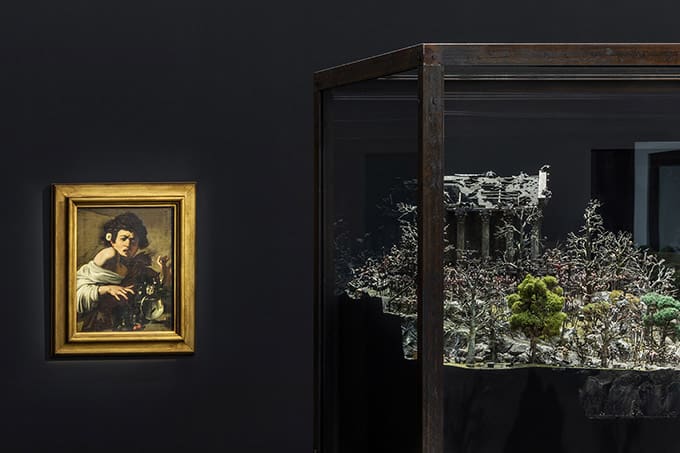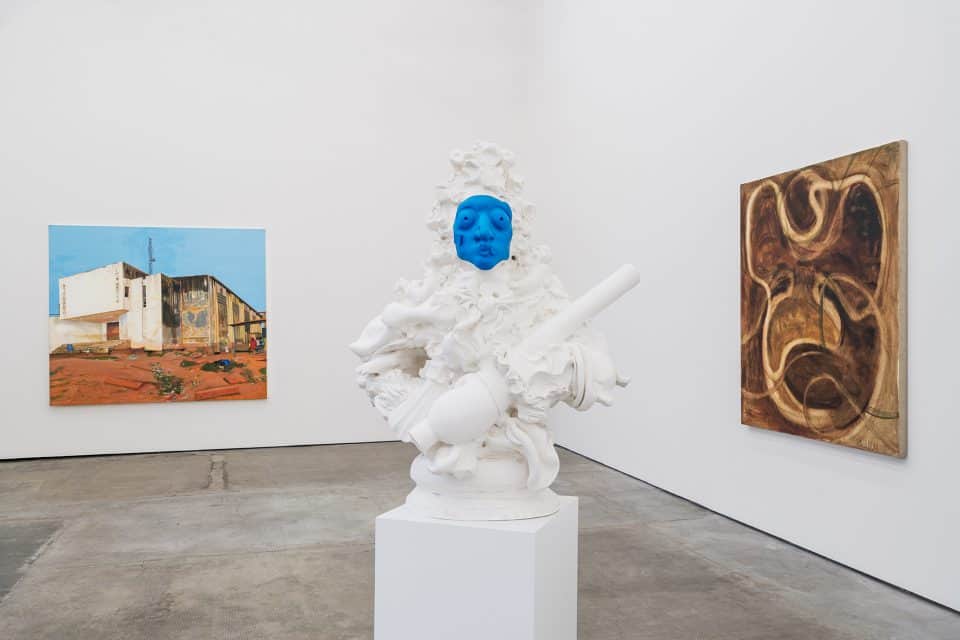A rather long list of 63 artists take part in the exhibition currently presented at the Fondazione Prada gallery. The high number of artists participating reflects the dramatic exaggeration often associated with Baroque itself. Located on the outskirts of the city of Milan this well-known, elegant art space showcases 80 works of art, curated by the famous painter Luc Tuymans. The exhibition opened on 18th October 2018 and lasts until 25th February 2019.

Carla Arocha and Stephane Schraenen, “Sanguine. Luc Tuymans on Baroque”. Photo: Delfino Sisto Legnani e Marco Cappelletti, “Sanguine. Luc Tuymans on Baroque”.
Organised in collaboration with M HKA (Museum of Contemporary Art Antwerp), KMSKA (Royal Museum of Fine Arts Antwerp) and the City of Antwerp, the exhibition was first presented from June to September 2018 at M HKA, and is is now featured in the capital of Lombardy, in a new, extended version.
“Sanguine” means blood; flaming red; an emotional and changeable type of character; and also refers to one of the oldest graphic techniques used by painters and draftsmen. As Tuymans explains: “Blood is a dynamic element, it refers to the flow of life and death energy. A red colour, typical of the Baroque, has the same strength, can refer to blood, but also to colonialism and propaganda.”
Needless to say, Baroque is known world-wide for its elaborate ornamentation and dramatic effects. While all the pieces presented in the exhibition are somehow connected to this famous style of art only a few of them are historic pieces from the period. The fact that the exhibition is composed of works by both contemporary artists and Old Masters, including 16th and 17th century works from museums, creates a really tasty visual and meritorical mixture.

“Sanguine. Luc Tuymans on Baroque”. Photo: Delfino Sisto Legnani e Marco Cappelletti, “Sanguine. Luc Tuymans on Baroque”.
Deep down below the surface Baroque is a pure sentimental obsession, an artistic passion. It’s a style in art characterized by being emotional, symbolic, mystical, bloody, theatrical and dominated by the thought of death. Apparently, it has so much more to offer than just the strong chiaroscuro effect. Brought to life as an opposition to the rational Renaissance, the praise of order and harmony, Baroque, thanks to Luc Tuymans and Fondazione Prada, is having its moment a few centuries after its beginnings.
While it all sounds quite carefully planned, the curatorial effort put into the project was more of a visual and intuitive work. In order to choose the right works to represent Baroque, Tuymans relied on the commonly held notion of Baroque, as well as looking for works with a single “Baroqueish” feature or an overall Baroque-like impression. The installation “Fucking Hell” (2008) by Jake and Dinos Chapman is displayed nearby Caravaggio’s “Boy Bitten by a Lizard” (around 1594-1596). A rather noisy “Vlaamse Blokfluiten” (2012) by Dennis Tyfus creates a soundtrack in the background to “In Flanders Fields” (2000), a sculpture of suffering and knocked-over horses, created by Berlinde De Bruyckere. On the wall nearby, we find ourselves staring at the soul-stirring painting “Dead Girl” (2002) by Marlene Dumas and just a stone’s throw away we face a cold and monochromatic “Circa Tabac” (2007) by Arocha and S. Schraenen; a triangular floor construction with mirrors, which repeats endless reflections of its environment. Everything within the field of view of the installation is shredded, fragmented and reflected. Here, we cannot avoid noticing a multiplied reflection of “St. John the Apostle and Our Lady” (1758) by J. G. Pinsel.

“Sanguine. Luc Tuymans on Baroque”. Photo: Delfino Sisto Legnani e Marco Cappelletti, “Sanguine. Luc Tuymans on Baroque”.
Not far away we get attracted by the video “Harnessed swimmer” (2009) by Dominik Lejman. As it’s the only moving piece in this wide space of the room, it gets us to come closer and have a longer look. Projected onto the canvas is a skewed black rectangle on a grey background. Inside the rectangle, in the blackness of acrylic paint, we see an elderly man who, tied to the edge of the pool with a belt, despite all the effort he puts into motion, doesn’t move forward.
In the second room, just in the center of everything, we may happen to emotionally melt in front of twelve kinds of white flowers collected in a festive bouquet. The work “Bouquet IX” (2012) by Willem De Rooij refers to both historical and political spirituality of that time. It also ironically refers to the role of the Netherlands as a leader in the flower market and its historical tradition of still lifes. Taking a few more steps, we come across “Rio Lakota” (2017) by Cheikh Ndiaye. Appartently, even if primarily innocent, a painting has a strong magnetic vibe. Around the corner is “Thanatophanies” (1955–95) by On Kawara, which shows the deformed faces of victims of the nuclear bombs in Hiroshima and Nagasaki. “Guillotine Painting” (2016) by Vaast Colson, whose title seems to introduce us to a real drama of death, illustrates the artist’s exploration to question the essence of painting after being told he was not a “real painter” during his student days.

“Sanguine. Luc Tuymans on Baroque”. Photo: Delfino Sisto Legnani e Marco Cappelletti, “Sanguine. Luc Tuymans on Baroque”.
Fortunately, the works, separately as well as all together, remain in a balanced and harmonious state. There is a lot of cruelty on display, but it is spread-out wisely.
It’s fair to say that the exhibition tugs on the strings of humans’ internal conflicts and is apparently aimed at waking up their inner tensions. As Tuymans says in the video introduction to the exhibition, violence is his point of interest, and Baroque also deals with the idea of violence, as well as that of ecstasy, and this exhibition explores the mixture of these two ideas.
Written by Dobrosława Nowak
Edited by Lisa Barham
Fondazione Prada | SANGUINE. LUC TUYMANS ON BAROQUE from Fondazione Prada on Vimeo.
“Sanguine. Luc Tuymans on Baroque”
curator: Luc Tuymans
artists: Nick Andrews, John Armleder, Carla Arocha e Stéphane Schraenen, Fred Bervoets, Jacques-André Boiffard, Michaël Borremans, Adriaen Brouwer, Pavel Büchler, Jake e Dinos Chapman, Vaast Colson, Njideka Akunyili Crosby, Roberto Cuoghi, Berlinde De Bruyckere, Thierry De Cordier, Willem de Rooij, Cornelis de Vos, Lili Dujourie, Marlene Dumas, Zhang Enli, Luciano Fabro, Giuseppe Gabellone, Marcel Gautherot, Isa Genzken, Joris Ghekiere, David Gheron Tretiakoff, Franciscus Gijsbrechts, Pierre Huyghe, Jonathan Johnson, On Kawara, Zlatko Kopljar, Dominik Lejman, Ives Maes, Mark Manders, Diego Marcon, Kerry James Marshall, Takashi Murakami, the Master of the annunciation to the shepherds, Bruce Nauman, Nadia Naveau, Cheikh Ndiaye, Vanja Radauš, Tobias Rehberger, Alex Salinas, Yutaka Sone, Henri Storck, Pascale Marthine Tayou, Javier Téllez, Paul Thek, Piotr Tolmachov, Luc Tuymans, Dennis Tyfus, Jan Van Imschoot, Jan Vercruysse, Michaelina Wautier e Jack Whitten
Mediolan, Fondazione Prada
18.10.2018 – 25.02.2019








